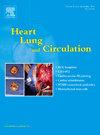Survival Analysis of Early-Stage NSCLC Patients Following Lobectomy: Impact of Surgical Techniques and Other Variables on Long-Term Outcomes
IF 2.2
4区 医学
Q2 CARDIAC & CARDIOVASCULAR SYSTEMS
引用次数: 0
Abstract
Background
Surgical resection is a frontline management option for early-stage non-small cell lung cancer (NSCLC). Evolving techniques may be refining patient outcomes. This study compares the long-term survival of patients undergoing lobectomy for a primary NSCLC between video-assisted thoracoscopic surgery (VATS) and open thoracotomy (OT). The secondary aim of this study is to identify the variables that influence immediate and long-term patient outcomes.
Method
This is a single-centre retrospective cohort analysis spanning 20 years. The study reports on the outcomes of 743 patients who underwent lobectomy for primary NSCLC. There are 598 VATS cases and 145 OT cases. Variables likely to influence long-term survival were assessed with Kaplan–Meier survival analysis. The effect of VATS on long-term survival was assessed using a propensity-adjusted analysis.
Results
Chronic obstructive pulmonary disease, history of other cancers, coronary artery disease, type 2 diabetes, and emphysema were the most common comorbidities reported in this cohort. The VATS technique showed shorter postoperative length of stay and fewer surgical complications compared with OT. There were no differences between VATS and OT in early mortality or completeness of the resection. Additionally, 32% of patients showed variable visceral pleural invasion (P1–P2), and their 5-year survival was significantly worse compared with P0 patients (18.75% and 36.85%, respectively). Major pulmonary complications were responsible for prolonging the length of hospital stay after index surgery and it was inversely related to the survival at 5 and 10 years (p<0.0004). Lymph node involvement was an important predictor for long-term survival (50% overall survival rate was 9.4 years, 4.5 years and 4.2 years for N0, N1, and N2, respectively). We observed longer median survival in the VATS group (10.04 years vs 8.99 years) and a lower risk of mortality after propensity analysis (odds ratio 0.86; 95% confidence interval 0.67–1.11), but neither observation was statistically significant.
Conclusions
Early surgical outcomes were significantly better in the VATS group, whereas long-term outcomes were not notably different between the groups. Regardless of the surgical techniques used, positive surgical margins, visceral pleural invasion, larger tumours, positive lymph nodes, age >70 years, and prolonged hospital stay were common variables responsible for the poor overall long-term survival.
肺叶切除术后早期非小细胞肺癌患者的生存分析:手术技术和其他变量对长期预后的影响。
背景:手术切除是早期非小细胞肺癌(NSCLC)的一线治疗选择。不断发展的技术可能会改善患者的治疗效果。这项研究比较了在电视胸腔镜手术(VATS)和开胸手术(OT)中接受肺叶切除术的原发性非小细胞肺癌患者的长期生存率。本研究的第二个目的是确定影响患者近期和长期预后的变量。方法:这是一项跨越20年的单中心回顾性队列分析。该研究报告了743例因原发性非小细胞肺癌接受肺叶切除术的患者的预后。有598个增值税案件和145个OT案件。用Kaplan-Meier生存分析评估可能影响长期生存的变量。使用倾向校正分析评估VATS对长期生存的影响。结果:慢性阻塞性肺疾病、其他癌症史、冠状动脉疾病、2型糖尿病和肺气肿是该队列中最常见的合并症。与OT相比,VATS技术术后住院时间短,手术并发症少。VATS和OT在早期死亡率和切除的完全性方面没有差异。32%的患者表现为变异性内脏性胸膜侵犯(P1-P2),其5年生存率明显低于P0患者(分别为18.75%和36.85%)。主要肺部并发症是指数手术后住院时间延长的原因,与5年和10年生存率呈负相关(p结论:VATS组早期手术结果明显更好,而长期结果在两组之间无显著差异。无论采用何种手术技术,手术切缘阳性、内脏胸膜浸润、较大肿瘤、淋巴结阳性、年龄70岁和住院时间延长是导致总体长期生存率低的常见变量。
本文章由计算机程序翻译,如有差异,请以英文原文为准。
求助全文
约1分钟内获得全文
求助全文
来源期刊

Heart, Lung and Circulation
CARDIAC & CARDIOVASCULAR SYSTEMS-
CiteScore
4.50
自引率
3.80%
发文量
912
审稿时长
11.9 weeks
期刊介绍:
Heart, Lung and Circulation publishes articles integrating clinical and research activities in the fields of basic cardiovascular science, clinical cardiology and cardiac surgery, with a focus on emerging issues in cardiovascular disease. The journal promotes multidisciplinary dialogue between cardiologists, cardiothoracic surgeons, cardio-pulmonary physicians and cardiovascular scientists.
 求助内容:
求助内容: 应助结果提醒方式:
应助结果提醒方式:


